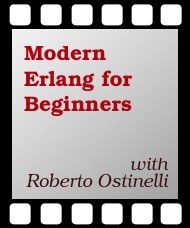Modern Erlang for Beginners
by: Roberto Ostinelli
| Published | 2018-06-13 |
|---|---|
| Internal code | v-roerlang |
| Print status | In Print |
| Pages | |
| User level | |
| Keywords | |
| Related titles | |
| ISBN | |
| Other ISBN | |
| BISACs |
Highlight
An in-depth introduction to coding with Erlang, a general-purpose, concurrent, functional programming language renowned for its ability to create distributed and fault-tolerant systems.
Description
Modern Erlang for Beginners provides a thorough introduction to the Erlang programming language from the very basics to building your first Erlang/OTP application.
This course takes a very structured approach of teaching Erlang. The screencasts show you how to get started, in a gradual journey from understanding basic concepts such as pattern matching, to writing your first OTP application. You will learn how to use behaviours to build supervised and distributed systems, through clear examples and detailed explanations.
Why Erlang? The Erlang runtime system is known for its designs that are well suited for systems with the following characteristics:
- Distributed
- Fault-tolerant
- Highly available (non-stop applications)
- Support Hot Code swapping (code can be changed without stopping a system)
Contents and Extracts
- Introduction
- Installing Erlang
- Integers & Floats
- Variables
- Atoms
- Tuples
- Lists
- Strings
- Binaries
- Records & Maps
- Modules
- Functions
- Recursion
- Advanced Recursion
- Guards
- Conditional Statements
- Map, Reduce & Anonymous Functions
- Processes
- Spawning
- Message Passing
- Process Registration
- Links & Monitors
- Distributed
- Creating Clusters
- Sending Messages Across Nodes
- The Bank Example
- The Bank Process
- The Supervisor & Main Module
- OTP
- Intro to OTP
- Convert Example: gen_server
- Convert Example: supervisor
- Convert Example: application
